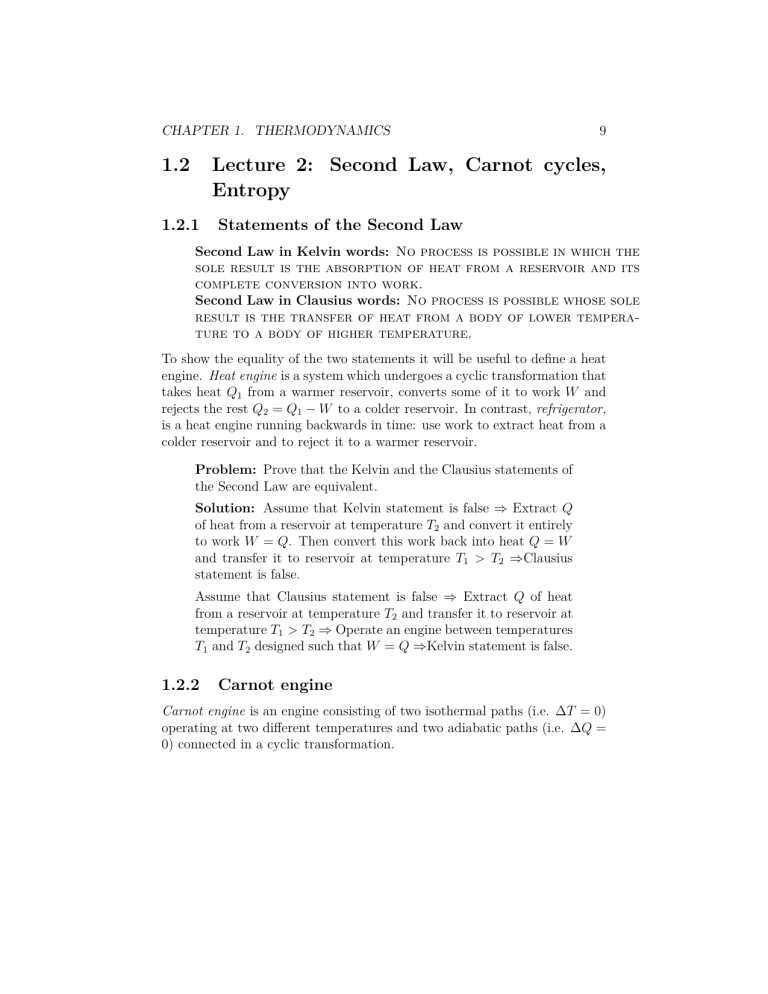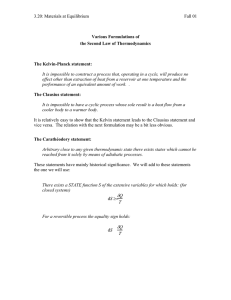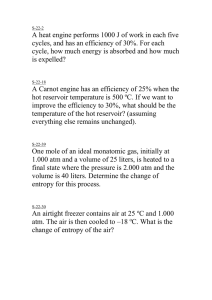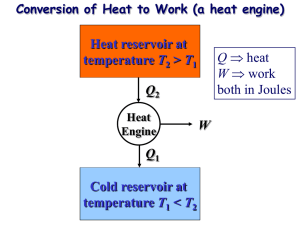
CHAPTER 1. THERMODYNAMICS 1.2 9 Lecture 2: Second Law, Carnot cycles, Entropy 1.2.1 Statements of the Second Law Second Law in Kelvin words: No process is possible in which the sole result is the absorption of heat from a reservoir and its complete conversion into work. Second Law in Clausius words: No process is possible whose sole result is the transfer of heat from a body of lower temperature to a body of higher temperature. To show the equality of the two statements it will be useful to define a heat engine. Heat engine is a system which undergoes a cyclic transformation that takes heat Q1 from a warmer reservoir, converts some of it to work W and rejects the rest Q2 = Q1 ≠ W to a colder reservoir. In contrast, refrigerator, is a heat engine running backwards in time: use work to extract heat from a colder reservoir and to reject it to a warmer reservoir. Problem: Prove that the Kelvin and the Clausius statements of the Second Law are equivalent. Solution: Assume that Kelvin statement is false ∆ Extract Q of heat from a reservoir at temperature T2 and convert it entirely to work W = Q. Then convert this work back into heat Q = W and transfer it to reservoir at temperature T1 > T2 ∆Clausius statement is false. Assume that Clausius statement is false ∆ Extract Q of heat from a reservoir at temperature T2 and transfer it to reservoir at temperature T1 > T2 ∆ Operate an engine between temperatures T1 and T2 designed such that W = Q ∆Kelvin statement is false. 1.2.2 Carnot engine Carnot engine is an engine consisting of two isothermal paths (i.e. T = 0) operating at two different temperatures and two adiabatic paths (i.e. Q = 0) connected in a cyclic transformation. CHAPTER 1. THERMODYNAMICS 10 The efficiency of engines is defined as ÷= W , Q1 (1.7) and for a Carnot engine it is given by ÷ =1≠ Q2 . Q1 (1.8) Carnot’s theorem: a) All irreversible engines operating between temperatures T1 and T2 < T1 are less efficient than a Carnot engine operating between the same temperatures. b) All reversible engines operating between temperatures T1 and T2 < T1 are equally efficient as a Carnot engine operating between the same temperatures. Proof: a) Combine an arbitrary heat engine whose efficiency is ÷ with a reversed Carnot engine whose efficiency is ÷ Õ so that there is no work done by the combined system. If ÷ = ÷ Õ then the process does nothing in conflict with irreversibility assumption. If ÷ > ÷’ then the process is in the conflict CHAPTER 1. THERMODYNAMICS 11 with Clausius statement of the Second Law, i.e. Q= ÷ Q ≠ Q > 0. ÷Õ Thus, ÷ Æ ÷’. Together ÷ Æ ÷ Õ and ÷ ”= ÷ Õ give us ÷ < ÷ Õ . b) We have already proved that ÷ Æ ÷ Õ regardless of reversibility. Now we can reverse the process by combining a reversed heat engine with a Carnot engine which leads to conclusion ÷ Õ Æ ÷. Together ÷ Æ ÷ Õ and ÷ Õ Æ ÷ give us ÷ = ÷Õ. According to Carnot’s theorem the efficiency of reversible process between any two temperatures is a universal number, i.e. ÷(T1 , T2 ). This allows us to define not only relative, but also absolute temperature scale. Consider three Carnot cycles 1-2, 2-3 and 1-3 operating between different temperatures T1 and T2 , T2 and T3 , T1 and T3 respectively, where without loss of generality we assume that T1 > T2 > T3 . We can now construct a combine cycle such that the heat Q2 rejected by 1-2 is absorbed by 2-3 which is a reversible and thus a cycle 1-3 by Carnot’s theorem. Then the heat absorbed by reservoir at T3 must satisfy both CHAPTER 1. THERMODYNAMICS 12 Q3 = Q1 ≠ W13 = Q1 (1 ≠ ÷(T1 , T3 )) Q3 = Q2 ≠W23 = Q2 (1≠÷(T2 , T3 )) = (Q1 ≠W12 )(1≠÷(T2 , T3 )) = Q1 (1≠÷(T1 , T2 ))(1≠÷(T2 , T3 )). Therefore and (1 ≠ ÷(T1 , T3 )) = (1 ≠ ÷(T1 , T2 ))(1 ≠ ÷(T2 , T3 )) 1 ≠ ÷(T1 , T2 ) = f (T2 ) f (T1 ) (1.9) for an arbitrary function f (T ) which is by convention is set to be a linear function, i.e. T2 T1 (1.10) Q2 T2 = . Q1 T1 (1.11) ÷ =1≠ and from the definition of efficiency 1.2.3 Entropy The Second Law suggests a new thermodynamical quantity, called entropy and usually denoted by S. It is conveniently introduced using Clausius’s theorem. Clausius’s Theorem: For any cyclic transformation j dQ Æ 0. T (1.12) The equality holds for cyclic transformations. Proof: Subdivide the cycle into infinitesimal transformations where the temperature T remains roughly constant. During each transformation the system receives dQ of heat and does dW of work. Arrange a series of Carnot cycles operating between temperatures T and TR where is the temperature of an arbitrary reservoir. The whole purpose of each Carnot cycle is to deliver to the system dQ of heat and to do dW of work. Then according to the absolute definition of temperature dW ≠ dQ TR = . dQ T (1.13) CHAPTER 1. THERMODYNAMICS 13 By integrating of entire cycle the total heat received by the system i is zero dQ = 0 and by the Kelvin’s statement of the Second Law i the total work must be non-positive dW Æ 0. Thus, j (dW ≠ dQ) = TR since TR > 0. j j dQ dQ Æ0 ∆ Æ0 T T (1.14) For a reversiblei cycle we can run the process in opposite direction i dQ to show that dQ Ø 0 which together with Æ 0 implies T T i dQ = 0. T An immediate consequence of the Clausius’s Theorem is sthat for reversible transformations between two states A and B the integral AB dQ does not deT pend on the path. Indeed if we take two distinct reversible paths parametrizes by dQ and dQÕ then together they would form a reversible cycle, i.e. ⁄ B A and thus, dQ ⁄ A dQÕ + =0 T T B (1.15) ⁄ B dQ ⁄ B dQÕ = . (1.16) T T A A This suggests that for a reversible transformation we can define and exact differential dQ . (1.17) T whose integral defines relative entropy up to an arbitrary constant of integration. This also produces a new pair of conjugate thermodynamic variables generalized force T and generalized displacement S, i.e. dS © dU = T dS ≠ P dV. (1.18) Although the entropy was defined using only reversible processes (as a reference), the Clausius’s Theorem implies that for all systems ⁄ B dQ T and for thermally isolated systems (i.e. dQ = 0) S(B) ≠ S(A) Ø A S(B) ≠ S(A) Ø 0 (1.19) (1.20) where the equalities hold for only reversible transformations. This shows that in a thermal equilibrium (when the state of the system does not change) the system must be in a state of maximal entropy. CHAPTER 1. THERMODYNAMICS Second Law in symbols: 14 dS Ø0 dt (1.21) Not all of the processes we observe in nature are reversible. Many processes are irreversible, which is a rather surprising fact given that the fundamental laws of physics (as we know them) are usually time symmetric. Then, why does the nature always picks some initial conditions and not other? Why don’t we see a thermal state? Why is there an asymmetry between past and future? Question To Go: Why do we see an arrow of time?





